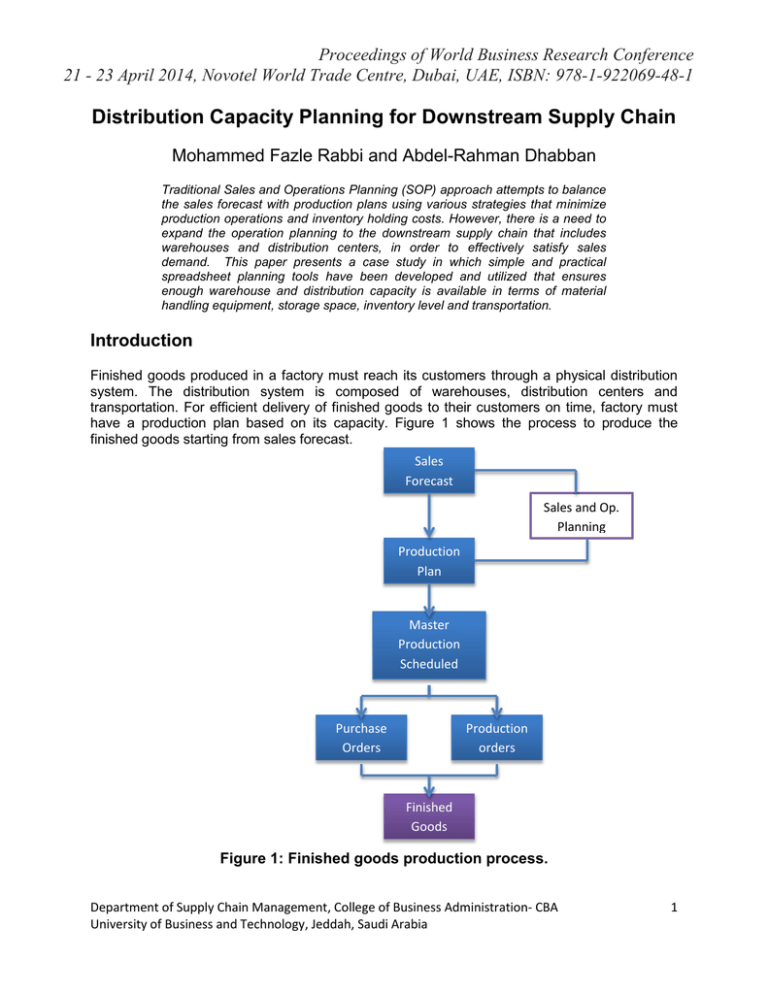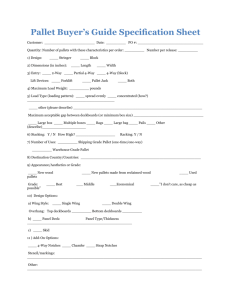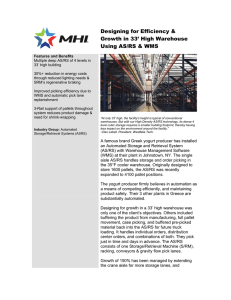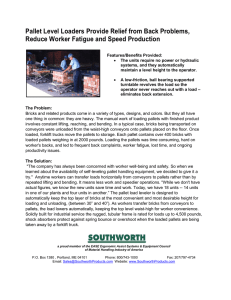Proceedings of World Business Research Conference
advertisement

Proceedings of World Business Research Conference 21 - 23 April 2014, Novotel World Trade Centre, Dubai, UAE, ISBN: 978-1-922069-48-1 Distribution Capacity Planning for Downstream Supply Chain Mohammed Fazle Rabbi and Abdel-Rahman Dhabban Traditional Sales and Operations Planning (SOP) approach attempts to balance the sales forecast with production plans using various strategies that minimize production operations and inventory holding costs. However, there is a need to expand the operation planning to the downstream supply chain that includes warehouses and distribution centers, in order to effectively satisfy sales demand. This paper presents a case study in which simple and practical spreadsheet planning tools have been developed and utilized that ensures enough warehouse and distribution capacity is available in terms of material handling equipment, storage space, inventory level and transportation. Introduction Finished goods produced in a factory must reach its customers through a physical distribution system. The distribution system is composed of warehouses, distribution centers and transportation. For efficient delivery of finished goods to their customers on time, factory must have a production plan based on its capacity. Figure 1 shows the process to produce the finished goods starting from sales forecast. Sales Forecast Sales and Op. Planning Production Plan Master Production Scheduled Purchase Orders Production orders Finished Goods Figure 1: Finished goods production process. Department of Supply Chain Management, College of Business Administration- CBA University of Business and Technology, Jeddah, Saudi Arabia 1 Proceedings of World Business Research Conference 21 - 23 April 2014, Novotel World Trade Centre, Dubai, UAE, ISBN: 978-1-922069-48-1 Historical sales data is used to forecast sales. Sales patterns may include steady demand, trend and seasonality besides unpredictable random variations. Using appropriate forecasting techniques, sales forecasts are made based on the above demand patterns. The Sales and Operations Planning (SOP) process is used to develop a production plan that uses inventory, and production capacity adjustments through extra resources and/or production time. In general, production capacities are costly to change. Therefore a level production plan or a hybrid production plan is used to balance between demand and production. This is illustrated in Figure 2. In both cases shown, inventory is used to balance between demand pattern and production plan. Thus necessitating store inventory items in temporarily in the finished goods warehouse until they are ‘pulled’ by actual sales order. Demand This production plan is made up of groups of similar items or SKU’s (stock keeping units). This production plan drives the rest of the process until finished goods are produced. Businesses use ERP or Enterprise Resource Planning systems for planning and controlling the whole process. Sales Production Use invetory Add inventory Demand Time Sales Use invetory Production Production Add inventory Time Figure 2: Using inventory to balance sales demand with level and hybrid production plan. Department of Supply Chain Management, College of Business Administration- CBA University of Business and Technology, Jeddah, Saudi Arabia 2 Proceedings of World Business Research Conference 21 - 23 April 2014, Novotel World Trade Centre, Dubai, UAE, ISBN: 978-1-922069-48-1 Functions of the Finished Goods Warehouse: As discussed in the previous section, a finished goods warehouse is needed to temporarily stock finished and packaged items for the following reasons: For immediate or same day delivery to distribution centers. This quantity stored is equivalent to daily average shipments during a production plan. Short-term storage for safety stock due to random variation in the demand. Usually this is equivalent to a days supply. Long-term storage to store for seasonal variation. Figure 3 illustrates these functions. It is divided into slow moving seasonal stock to daily dispatch. Production Incoming Load Seasonal Stock Safety Stock: One Day Supply Daily Dispatch Delivery Dock Distribution Figure 3: Warehouse functions Warehouse capacity planning involves the following Analysis of daily incoming load and its pattern over the year. Analysis of daily outgoing dispatch and its variation during the year. During the time period when production rate is more than the delivery rate, items are stocked in the warehouse. When delivery is more than the production, extra demands are met by the Department of Supply Chain Management, College of Business Administration- CBA University of Business and Technology, Jeddah, Saudi Arabia 3 Proceedings of World Business Research Conference 21 - 23 April 2014, Novotel World Trade Centre, Dubai, UAE, ISBN: 978-1-922069-48-1 stocked inventory. The space allocation depends on the amount of difference during the months. The types of storage racks/shelves, storage condition such as temperature control, and material handling equipment will depend on the items produced and stored. In this case study we will discuss about a packaged food that do not require special temperature control and has long shelf life. The packages or cartons are loaded on a pallet. Pallets are stored on multi-level roller racks to facilitate FIFO (first-in-first out) inventory policy. Therefore the warehouse storage capacity will be expressed as number of pallet loads. The common handling equipment used in the warehouses is forklift truck. Depending on the configuration of the warehouse, forklift trucks are purchased. In our case study both electric and diesel forklifts are used. Diesel trucks are used for loading the delivery trucks to transport finished goods to the distribution centers. Capacity planning issues If proper capacity planning is not done in the finished goods warehouse, production may have to be shut down because of lack of space in case inadequate storage space, or warehouse space could be wasted in opposite case. Similarly, if there is a shortage of material handling equipment such as the forklifts or the delivery trucks to the distribution centers or even lack of space in loading and unloading areas, the warehouse operations and thus, customers at the retail stores will suffer. Warehouse management including daily scheduling of resources must follow the capacity planning. The capacity planning issues impact the downstream supply chain as shown in Figure 4. Retailers Distribution Centers FG Warehouse Customers Figure 4: Downstream supply chain for the finished goods (FG). Department of Supply Chain Management, College of Business Administration- CBA University of Business and Technology, Jeddah, Saudi Arabia 4 Proceedings of World Business Research Conference 21 - 23 April 2014, Novotel World Trade Centre, Dubai, UAE, ISBN: 978-1-922069-48-1 In this study we focused on the FG (Finished Goods) Warehouse capacity in pallet loads, forklift requirements for loading and unloading and truck requirements for distribution to the distribution centers. Distribution Capacity Planning The downstream supply chain distribution capacity planning involves the following steps: 1. Conversions of units of measures from forecasting units to pallet loads for each SKU (Stock Keeping Unit): a. From forecast quantity to weight (metric tons) for each period and then daily rate b. From weight (metric tons) to number of delivery packages (for retailers) or cartons c. From cartons to pallet loads daily 2. Calculation of average daily pallet loads produced in the factory during a period 3. Variation of daily pallet load production 4. Determination of number of forklift needed for incoming and outgoing loads based on forklift capacity and daily effective operating hours for each forklift type 5. Identify storage requirements for the warehouse in terms of number of pallet locations 6. Determine number of delivery dock locations for truck loading 7. Determine the number of delivery trucks, given the truck load capacity Case Study The case study described here is for a packaged food product. For confidentiality, the name, location and actual product name are not disclosed here. The finished product is liquid and packaged into plastic bottles and tin cans. There are more than 60 SKU’s produced. However, for the purpose of the analysis, they classified by their weights. Individual packages are then boxed in a carton for shipment. Since pallet size is used for our capacity calculation, we use the following formula for converting quantities (forecasted and actual sales) of each product size to pallets. Q = Quantity of forecast or sales CFQ= Conversion factor from quantity to number of cartons CFP= Conversion factor from number of cartons to number of pallets NP = Number of pallets NP= Q*CFQ/CFP Equation (1) The following Table 1, shows forecast for 2013 in quantities by the container sizes. The figures shows considerable variations in demand requiring the finished goods warehouse to store items when they are not needed immediately. Table 2 shows the CFQ and CFP for the various sizes. Department of Supply Chain Management, College of Business Administration- CBA University of Business and Technology, Jeddah, Saudi Arabia 5 Proceedings of World Business Research Conference 21 - 23 April 2014, Novotel World Trade Centre, Dubai, UAE, ISBN: 978-1-922069-48-1 Table 1: Forecast example Container sizes Jan Feb Mar Apr May Jun Jul Aug Sep Oct Nov Dec Average St. Dev. 9L & 10L 1960 870 865 1180 1100 1130 725 985 885 1035 980 925 1053 313 18L Can 12063 10500 14500 13951 16007 16545 13441 13000 14324 13987 14948 9535 13567 2062 1.8L Can 1510 1450 1380 1555 1920 1805 1395 1620 1510 1455 1455 1135 1516 202 8500 7100 9500 9200 9500 9200 7700 9500 9200 8900 8980 5260 8545 670 930 1025 995 1090 1051 1105 960 830 990 890 720 938 3040 2730 3770 3625 3730 3638 2790 3380 3415 3160 3485 1950 3226 1.8L Plastic Small SKUs 3.5L Plastic Table 2. Conversion factors. Product 9L & 10L 18L Can 1.8L Can 1.8L Plastic Small SKUs 3.5L Plastic Conv. Carton/Pallet F. 48 57.885 60 60.931 84 102.375 64 101.554 50 97.494 42 78.339 Using the equation for NP (no of pallets- Eq. 1), we can see the following result in Table 3: Table 3. From quantity to pallets Product sizes 9L & 10L 18L Can 1.8L Can 1.8L Plastics Small SKUs 3.5L Plastics CFQ CFP Jan Cartons NP/Month NP/Day Percent 57.885 60.931 102.375 48 60 84 1,960 12,063 1,510 113,455 735,011 154,586 2,364 12,250 1,840 79 408 61 6.4% 33.1% 5.0% 101.554 64 8,500 863,207 13,488 450 36.6% 97.494 50 670 65,321 1,306 44 3.6% 78.339 42 3,040 238,151 5,670 189 15.4% 36,918 1,231 Total For example, for 9L & 10 L sizes, Jan NP (No of pallets) = 1960*57.885/48 = 2,364 per month which can be converted to number of pallets per day by diving by 30. (The company works seven days a week). The total forecasted daily pallet unloading is about 1231. Department of Supply Chain Management, College of Business Administration- CBA University of Business and Technology, Jeddah, Saudi Arabia 6 1277 139 532 Proceedings of World Business Research Conference 21 - 23 April 2014, Novotel World Trade Centre, Dubai, UAE, ISBN: 978-1-922069-48-1 Number of forklift trucks needed The company uses three different types of forklift for unloading. Let us call them FL-1, FL-2 and FL-3. After time and motion study we determined that both FL-1 and FL-2 are can load the racks for incoming production at the rate of average 40 pallets per hour. FL-3 can handle on the average 60 pallets per hour. One of the trucks FL-1 is an electric truck and can effectively work 8 hours per day. FL-2 also works two shifts and F3 works 8 hours per day. FL-1 works for both incoming and outgoing loads (so putting into storage and unloading from the rack). F2 is used only for loading the racks from production. F3 is only used for loading to delivery trucks for distribution centers. Number of forklift trucks required for each period is then calculated based on the following formula. NF= Number of Forklift truck NPD= Number of pallets forecasted or shipped out per day FC= Forklift capacity, pallets per hour (40 per hour for FL-1 and FL-2 and 60 per hour for FL-3) HR= Effective hours available per day ( 8 hours per day for FL-1 and FL-2 and 16 hours per day for FL-3. NF= NPD/(FC*HR) Using the above formula the number forklifts can needed each month is shown in Table 4 below. Table 4. Forklift requirements FL-1 FL-2 FL-3 Jan 5 3 3 Feb 5 2 3 Mar 5 3 4 Apr 4 3 3 May 6 3 4 Jun 5 3 4 Jul 5 3 3 Aug 4 3 3 Sep 5 3 4 Oct 5 3 3 Nov 5 3 4 Dec 5 2 3 Ave Max 5 3 3 Min 6 3 4 4 2 3 From the above table it can be seen that month of May has the highest demand. Table also shows the minimum and maximum. It is recommended that the company use the average number of forklifts and for pick loads use extra-hours or rent extra forklifts. Number trucks needed for delivery to distribution centers If the truck capacity is known in terms of number of pallets it can carry per trip and if we have the forecast, we can calculate the number of trips required. Let, TC= Truck capacity in number of pallets SF = Sales Forecast per day in number of pallets NT= Number of trips NTT = Number of round trips a truck makes a day, DT= Number of delivery trucks needed Then, NT= SF/TC DT= NT/NTT For example, if TC= 22 Department of Supply Chain Management, College of Business Administration- CBA University of Business and Technology, Jeddah, Saudi Arabia 7 Proceedings of World Business Research Conference 21 - 23 April 2014, Novotel World Trade Centre, Dubai, UAE, ISBN: 978-1-922069-48-1 SF= 1360 per day for January NTT= 5 Then, NT= 1360/22= 60 trips per day. DT= 60/5 = 12 trucks Warehouse storage capacity The space requirement for storage is illustrated in Table 6. Sales Forecast is shown on row 2. If an initial stock of 2500 pallets are assumed, the inventory balance at the last row shows number of pallets in store at the end of the month. This is based on a level production plan of 1336 – same as the average daily sales forecast. The end inventory is calculated as: End Inventory = Beginning inventory + production – sales forecast. From the table we find inventory in pallets varies from a minimum of 569 in August to a maximum of 8025 in April. With the production plan the company can arrange for storage racks for between 8000-8500. More seasonality and variations in demand will require more storage space. Distribution of storage space Proper planning and scheduling will help allocation of this storage space between the finished goods warehouse and the distribution centers. Suppose the production plant distributes to 10 distribution centers or DC’s. Each distribution center can be designed to store 500 pallets of all the SKU’s mix. This will need about 3000 total pallet racks at the finished goods warehouse. Table 6. Storage requirement calculation. Jan Feb Mar Apr May Jun Jul Aug Sep Oct Nov Dec 29596 29805 31702 27620 33155 35381 33707 26788 29133 30781 30830 32969 24 22 24 23 24 23 24 20 22 24 24 24 Av. Daily 1233 1355 1321 1201 1381 1538 1404 1339 1324 1283 1285 1374 Production 1336 1336 1336 1336 1336 1336 1336 1336 1336 1336 1336 1336 32064 29392 32064 30728 32064 30728 32064 26720 29392 32064 32064 32064 4968 4555 4917 8025 6934 2281 638 569 828 2111 3345 2440 Forecast No.of days Monthly Prod Inventory On hand 2500 Summary In this paper we presented a number of simple and practical formulas for distribution capacity planning for the downstream supply chain. We showed how sales forecast and production plan can be utilized to determine incoming and outgoing handling capacity of different types of forklift trucks, delivery trips and trucks capacity and storage requirements to balance between planned production (level production) and actual sales. Use of the formulas has been demonstrated through a case study example. Department of Supply Chain Management, College of Business Administration- CBA University of Business and Technology, Jeddah, Saudi Arabia 8 Average 30956 1337 1336 Proceedings of World Business Research Conference 21 - 23 April 2014, Novotel World Trade Centre, Dubai, UAE, ISBN: 978-1-922069-48-1 References Wallace, Thomas A, and Robert A Stahl, Sales and Operations Planning, 3rd Edition, T.F. Wallace and Company, 2008 Arnold, J.R. Tony, Stephen N Chapman and Lloyd M. Clive, Introductions to Materials Management, 7th Edition, Prentice Hall, 2012 Hanke, John E., and Dean W. Wichern, Business Forecasting, 9th Edition, Prentice Hall, 2009. Department of Supply Chain Management, College of Business Administration- CBA University of Business and Technology, Jeddah, Saudi Arabia 9




